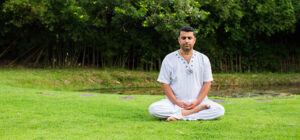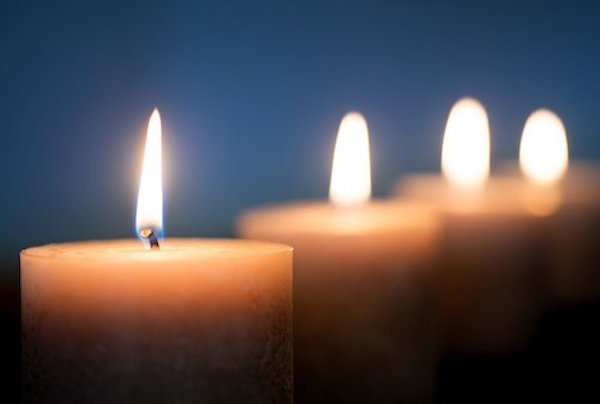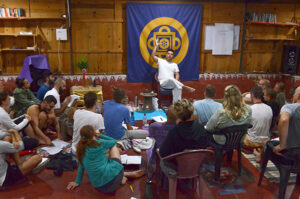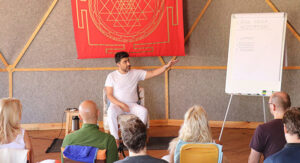How and Why One Must Prepare for Death
5 November Nov 2019
This is an interview conducted by a Slovenian journalist Mateja Hana Hočevar with a senior teacher of our school, Dharmananda, on the rare teachings of the Art of Dying. The original interview was published in the Slovenian magazine “Ona” on 29 October 2019.
1. You are an Israeli who has lived for the past two years in Estonia. How did you end up there?

My brother, Somananda, who is the founder of Somananda Tantra School, embarked on a spiritual path more than twenty years ago.
He also tried to lure me into yoga, spirituality, meditation, but at that time I had a job and was not all that interested. A year and a half later, I decided to try and understand the source of his enthusiasm. I travelled to India and participated in several yoga courses. I began to be more interested in spirituality and began a personal spiritual practice. Not longer after I also became a yoga teacher myself.
In 2010 an acquaintance offered Somananda the opportunity to run a workshop in Estonia. He met his future wife, Liisa, there. Later he needed help at the school in Estonia and asked me to join him and so I went and began teaching there and also in other places throughout Europe.
“I do not want to think about that (death and dying) now. I just want to live and enjoy what I have.”
2. You recently gave a four-day workshop in Ljubljana entitled “The Art of Dying”. How can we gain deeper insights into life through an understanding of death and dying?

The concept of death in modern times is considered to be more or less taboo. People perceive it as a morbid theme.
If you meet people who are relatively young and healthy and are enjoying life, and you mention death, they turn away and say: “I do not want to think about that now. I just want to live and enjoy what I have.” Although young people also die in accidents or as a result of disease, they think this will not happen to them.
An encounter with death is truly unpleasant and when it happens it causes an inner shock, like a cold shower. When we lose somebody close to us or we become very sick ourselves, it can lead us to an inner awakening. It shows us something that is part of reality and waits for each of us. We begin to realize the transitory nature of our lives and that death can come at any time.
If we are courageous enough, we give priority to the things that are most important. Before that we build castles in the sky and soothe ourselves with activities and pleasures that pass the time.
But it is good to be prepared for death, even if we consider ourselves young and healthy. In the Art of Dying course, I teach how to face death in an accepting and harmonious way.
3. Death can be a big motivator.
Even people who have had an accident or gotten sick, but didn’t look death directly in the eyes, can experience a significant shift within themselves. The shock may help them begin to appreciate life more.
I had an accident two years ago on my bicycle. I was not in mortal danger, but I sustained injuries and complications with my health. This experience encouraged me to more seriously dedicate myself to my spiritual practice and go in the direction I wanted to go.

I know people who have had a close encounter with death and afterwards began to realize how precious is the time that still remains to them. Afterwards, they no longer wasted time watching television, surfing the internet and social media that had previously distracted their minds. They focused more on the things that were really important so they would not have regrets when they will lie on their death beds.
4. Australian writer, Bronnie Ware, who tended to the dying for many years wrote a book entitled, “Five Top Regrets of the Dying”. People most regret if they did not dare to live life the way they wanted to. They often wish that they had not worked so hard, that they had the courage to express their emotions, to remain in touch with friends, and to allow themselves more happiness.
A lot of people are workaholics. They work hard at their jobs and then they come home and work more. That is how they keep their minds busy and escape from their true selves and the deeper aspects of their true nature.
Worse still, they don’t pay attention to their children, partners, and friends. This is the trap of the human ego in modern times as it seeks success, money and status all the while forgetting the most important things in life.
“It is not possible to live today in a correct manner unless we live as if it were our last day alive.” ~Gaius Musonius Rufus
5. Death is the moment of truth and, as you said, it is not good that we are unprepared for it. Why do we avoid talking about it? Why do we experience it as a morbid theme?

Our minds prefer entertainment and pleasure.
If NASA announced today that in twenty-four hours an enormous meteorite would hit the earth and destroy us all, how would we respond to this news? The ancient Roman philosopher Gaius Musonius Rufus said: “It is not possible to live today in a correct manner unless we live as if it were our last day alive.”
As modern human beings we live with the expectation that life will just continue.
What would be the response of most people when they heard the news about the meteorite? Many would spontaneously respond by using their final moments to party and to drink themselves unconscious. But that is a panicked response.
The more conscious response of those who understand the significance of spiritual practice would be very different. They would not lose any time. They would unplug their telephones, go into their rooms, meditate, pray, or engage in other activities that would connect them to their cores.
At such a moment they would realize that this is the essence and purpose of their lives. Not projects, not earning money, not socialising, not building fancy houses, etc. All of that is transitory and impermanent: it comes, and it goes. What remains is our Selfhood, what we are at our core.
That is what we are confronted with at the moment of death. At that time, we suddenly realize who we really are. This is the gift we can receive from the encounter with the possibility of our death.
If during meditation we go deeply into ourselves, we realize that death is inevitable for all of us. This experience can be a powerful motivator for making us live the way we should – immersed in spirituality and on an authentic spiritual path. Then we will not reproach ourselves on our death beds for wasting our lives on things that were actually unimportant.
6. The Slovenian author, Milan Kleč, wrote a book about the final farewell. The following sentence appeared on the back cover: “Death is not something that belongs only to the dead but something that must be lived.”
His sentence concisely describes what I was trying to explain before. When people learn that they will soon die or that someone near them will, their attention is all of sudden turned only to this event.
What have they done in the past decades to prepare them for this moment? Not much. Most people are unprepared for death.
In certain cultures, such as the Tibetan culture (and unfortunately there are not many of them left), people realize the importance of spiritual preparation for the moment of death. These themes are spoken of from youth onwards.
Sogyal Rinpoche, author of the extraordinary book, “The Tibetan Book of Living and Dying”, writes about this. He grew up in a community where he meditated and carried out other forms of spiritual exercises each and every day. It is believed that the entire purpose of life is preparation for the moment of death. The finale of the human experience is extremely precious from a spiritual perspective. Indeed, it offers us the opportunity for enlightenment.
7. Is the condition of deep sleep without dreams similar to death?

The time when we sleep is similar to death in that we are not consciously present. Stephen LaBerge, a leading researcher of lucid dreaming, says that we can learn to be consciously present during dreams and that this is very good preparation for the moment of death.
If we successfully develop the capacity for lucid dreaming, we can remain conscious in the moment our physical body dies, and realize that the eternal part of ourselves, our soul, remains after death. If we come to realize this during our lives, we have mastered the greatest fear: the fear of death.
8. Practicing for death also means being unattached. Mostly we are attached to our bodies, our partners, our friends, relationships, to material goods. “People who live simply, also die more easily,” said Urška Lunder, a leading doctor of palliative care in Slovenia.
It’s true. People who live simply have fewer attachments. The more things we have, the more our minds are engaged with them. Without them, our minds are much calmer.
You know the saying: “He who is truly rich has no desires.” It is not necessary to live an ascetic life. It is possible to find a middle path. To enjoy the beauties of life and at the same time not be attached to them. This does not mean apathy.
If we realize who we really are and what is the meaning of our existence, that all of the things and people around us, and even our own bodies, are transitory, then it is possible for us to remain unattached, or detached as the yogis say.
We can love someone sincerely, have money, a house, and a car, but not actually possess these things. They do not consume our minds or encroach upon our inner peace. Whether we have them or not we are one with our true nature.
“Death is not something that belongs only to the dead, but something that must be lived.”
9. How can we prepare ourselves spiritually for death so that we are able – when our time comes – to consciously and with dignity give ourselves to the process of dying.

Above all, it is important that we do not sweep the idea of death under the carpet but confront our own mortality. We should read books about it so that we will have a greater understanding of this important passage.
At the four-day workshop mentioned before, we speak a lot about the “Tibetan Book of the Dead (Bardo Todol)”. This is a sort of handbook on how to prepare for death.
Meditation is also advisable. With the help of meditation, we obtain insights into how our souls work.
Descartes’s maxim “I think, therefore I am” does not present the true essence of human beings. There exists something in us that is above the mind and thoughts, and that is pure consciousness. That is why some people turn the phrase around and say: “When I am not thinking, I am.” When I think, I am the slave of the mind.
If we learn how to take a step back and notice the mind as it directs us towards fear, negative perceptions, desires, and many other things, we can control it. Whoever can do that can also tame the mind during the moments of death and come to realize that it is a natural process which we all must go through. He or she will not be afraid and will be able to give into it more easily.
10. We are helped at birth but not at death. How can we accompany and support the dying during their passage?
Sit beside them and read them passages from “The Tibetan Book of the Dead”. That will help to relax them. The content of the book and the energy of the words are harmonious and calming.
Bring into the room pictures of people who have been important to them. These can also be pictures of saints and spiritual teachers. Light candles so that the space of dying becomes a temple.
You may meditate and pray beside the dying. You may also chant mantras. Any kind of supporting spiritual energy will help. You can try to support them through conversation, help them to realize their true nature, and that death is merely a transition to another level of being or existing.
The most powerful way of helping, however, is knowing the Art of Dying. This is the most profound and complete teaching on the topic of dying available to us.
11. One of the participants in your workshop had this response. “My father is on his deathbed. Before this class, I avoided thinking about his death. Now I know how to help him, and to stand by both of our sides, his and mine.”
That is a very frequent response. The workshop helps the participants to become calm. It alleviates the stress of losing someone close to them. Relatives often regret that they did not do more for the dying. Participants in our workshops acquire the tools to support the passage of the dying. The realization that they will do everything in their power gives them greater confidence.
12. You also teach Tantra. For a full, erotic existence it is good to realize that everything passes, everything dies. What is the connection between sexuality and death, between Eros and Thanatos?

What happens when we experience an orgasm? The mind suddenly stops, freezes, and this is similar to death. That is why in French an orgasm is called la petite mort, the little death.
The mind can also stop during tantric lovemaking. We find ourselves in a higher state of consciousness, as if we are outside of our bodies. In this instance, we realize who we really are – that we are not just bodies, thoughts, or emotions. Only the present moment exists, only our Selfhood.
This inspiring experience of nothingness, or the great void, is made possible in sexual union. And that is also a good preparation for death. If we frequently engage in tantric lovemaking, we grow accustomed to the state of emptiness. We are not frightened during the last moments of life because we are familiar with the state of emptiness.

Dharmananda
Senior Teacher
Born in Israel in 1977, Dharmananda could be described as a modern-day “Crouching Tiger, Hidden Dragon” of Yoga. He is a meditation master.

Recommended Course

The Art of Dying
Life’s greatest passage explained
